On Which Continents Have Similar Animal And Plant Fossils And Similar Rock Layers Been Found?
Information On This Page Navigation
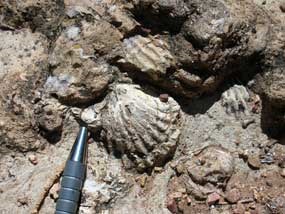
Introduction
Grand Coulee has so much more than than pretty scenery. It contains an astonishing variety of rock formations with an abundance of fossils subconscious inside.
- The sedimentary rocks exposed throughout the canyon are rich with marine fossils such equally crinoids, brachiopods, and sponges with several layers containing terrestrial fossils such every bit leaf and dragonfly fly impressions, and footprints of scorpions, centipedes, and reptiles.
- Aboriginal fossils preserved in the stone layers range from algal mats and microfossils from Precambrian Fourth dimension i,200 1000000 to 740 1000000 years ago to a multitude of body and trace fossils from the Paleozoic Era 525-270 million years ago.
What virtually dinosaur fossils? Not at Grand Canyon! The rocks of the canyon are older than the oldest known dinosaurs. To see dinosaur fossils, the Triassic-aged Chinle Formation on the Navajo Reservation and at Petrified Woods National Park is the nearest place to go.
It is illegal to dig up, relocate, and/or remove fossils from G Canyon National Park. If you notice a fossil, please go out it for others to discover and scientists to written report. You are welcome to have a flick or make a drawing of the fossil, then go to one of the company centers to run into if a park ranger tin can help you identify it.
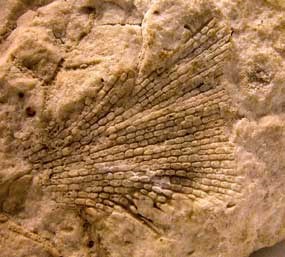
Fossils are the preserved remains of ancient life, such as bones, teeth, wood, and shells. Trace fossils correspond the presence or behavior of ancient life, without body parts beingness nowadays. Footprints, worm burrows, and insect nests are examples of trace fossils.
Sedimentary stone contains fossils considering it was built up layer upon layer, often trapping and preserving animals, plants, footprints, and more within the layers of sediment. If all the weather are right, fossils are formed as the layers of sediment turn into rock.
With 32% of World's geologic history and 1 billion years of fossil life plant at M Canyon, this is a great place to study ancient environments, climate changes, life zones, and the geologic processes that formed the landscape as nosotros see information technology today. The following are the most common and well known groups of fossils found at the canyon. Many more await our discovery.
Visit our keyboard shortcuts docs for details
- Duration:
- 25 minutes, 48 seconds
Bring together us back in time to explore the unique fossils found at Grand Canyon! From over 500 to 280 million years, the park preserves many dissimilar environments and organisms of the geologic past. You will larn about trace fossils, the organisms that fabricated them, and their paleoenvironments through fourth dimension.
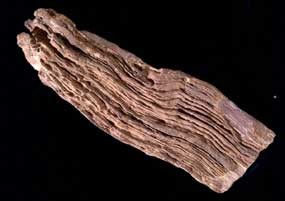
Marine Fossils
With marine environments creating many of the sedimentary rock layers in the canyon over the by 525 million years, marine fossils are quite common. Species changed over time, but similar fossils can exist establish in most of the marine-based rocks at Thousand Coulee.
Stromatolites
The oldest fossils at Grand Coulee are 1,200 million to 740 million years old. Stromatolites are the limestone structures formed by photosynthesizing leaner called cyanobacteria. They created layers of alternate slimy bacteria and sediment in very shallow h2o, dominating shallow seas until predators, such every bit trilobites, came into the movie. Today stromatolites merely live in a few shallow ocean areas with high salinity. The salinity deters predation and allows the stromatolites to survive.
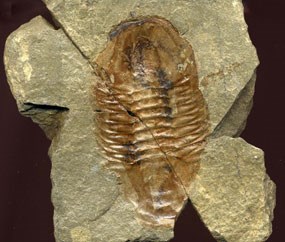
Trilobites
Yard Coulee's oldest trilobites are institute in the Tonto Group, which is betwixt 525 and 505 one thousand thousand years one-time. It includes the Tapeats Sandstone, Bright Angel Shale, and Muav Limestone. These fossils are arthropods, or articulation-footed animals, with a segmented body of hinged plates and shields. They could curlicue up into a ball for protection, sometimes fossilizing as a "rolled" trilobite. Like arthropods today, trilobites molted as they grew, shedding their erstwhile exoskeleton. These molts could fossilize, so one animal could go out several unlike sized fossils behind.
Even though trilobites were relatively primitive animals, they had amazingly complex optics. Many species had faceted optics like an insect, using up to xv,000 lenses in one eye.
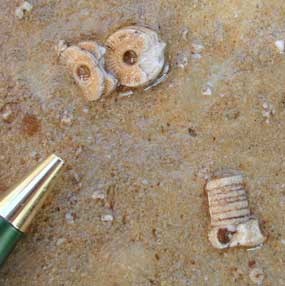
Crinoids
Though plant-like in appearance, crinoids, or bounding main lilies, were animals, sometimes described as seastars on a stick. They had structures like "roots" that could hold them in place, collect food, circulate fluid, and even act like feet in some species then they could walk beyond the sea flooring. They had a "stem" or column shaped body created past a serial of discs stacked together with a cardinal nerve running through. At the elevation of the trunk was a cup-similar head with feeding structures radiating out from each. These feathery arms had some structural support and could be used in some species for itch or swimming, though they were primarily used for filtering and capturing food from the h2o.
In the ancient seas these crinoids were then plentiful they formed "gardens" on the sea flooring. Discs, individually or sometimes still stacked together, tin can exist found in all the marine layers at Grand Coulee. These were the hardest parts of the animal and most readily preserved equally fossils.
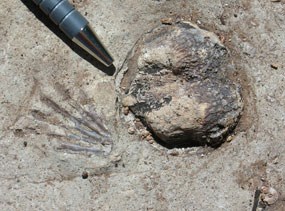
Brachiopods
The virtually mutual shelled animal in the ancient seas was the brachiopod. From about 20,000 species of brachiopods, only about 300 species be today. They are found in every Paleozoic marine layer at the canyon. Brachiopods had two asymmetrical shells, or valves, with one larger than the other. They often fossilized whole because when their muscles were relaxed, as in expiry, the valves were closed. They contracted their muscles to open the valves and filter feed.
They lived on the body of water floor attaching themselves with strong threads or using the shape of the shell and/or ridges on tiptop of the shell to stabilize them in soft mud or sand. A few species had long spines on either side that helped them to remain stable in faster currents or moving ridge action.
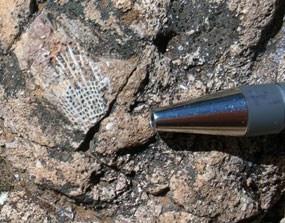
Bryozoans
Lacy and stick bryozoans similar to those in our oceans today, were also found in ancient seas. These colonial animals produce "lacy" structures on hard surfaces or "stick" structures that stood upwardly into the h2o column. Each animal has its own sleeping room within the colonial structure from which information technology can extend feeding arms into the water cavalcade or retract them for protection.
Bryozoans are passive filter feeders, collecting organic material and plankton from the water. Scientists sometimes refer to bryozoans as "moss animals" considering when their arms are out feeding, they sometimes look similar moss covering a surface.
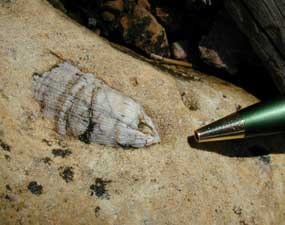
Corals
Corals secrete a hard skeleton of calcium carbonate which readily fossilizes nether the correct conditions. One type of coral found in the ancient marine layers of the canyon is the horn coral. This solitary coral lived on the sea flooring, with the pointed stop of its "horn" embedded in the soft sediment for stability and the wider end with a cup-like low in which the animal lived.
Corals take a polyp shape, similar to its relative the jellyfish. Information technology tucks its trunk into its skeleton and extends tentacles into the water column for feeding. Corals take a spiral of tentacles lined with nematocysts, or stinging cells, which can capture plankton floating by within reach.

Sponges
Living attached to the ocean floor, sponges are a colony of single-celled animals that act similar a multi-cellular beast. Each individual animal has a specific chore, from filtering water for food to protection. Fossil sponges exist because of a unique skeletal structure. Microscopic silica or calcium carbonate spicules, or interlocking spines, provided structural support. When the sponge died, the spicules clumped together and formed a silica mass. When hardened into rock the mass became a chert nodule. Chert is harder than the limestone stone it is embedded in, causing the nodules to protrude from the rock every bit erosion occurs. With and then many sponges in the aboriginal seas, layers like the Kaibab Limestone are really more resistant to erosion because of the chert nodules.
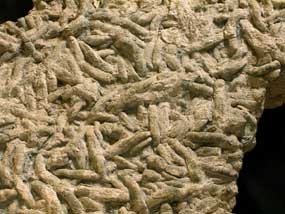
Burrows
Trace fossils are left behind by the activities of ancient organisms. Burrows are a classic example of a trace fossil. Animals burrowed through the soft sediment at the bottom of the aboriginal seas. Under the right atmospheric condition, these burrows were preserved when they filled in with sediment. The animals are not usually present, but evidence of their behavior or activities is represented in the trace fossil.
Terrestrial Fossils
Several of the rock layers in the coulee are of terrestrial origin, including the Hermit Shale, Supai Group, Coconino Sandstone, and Surprise Canyon Formation.
The mudstones and siltstones of the Hermit Shale and Supai Group were laid down by a meandering organization of rivers and streams in a semi-arid climate about 280 1000000 years ago. The sand grains of the Coconino Sandstone were deposited by wind across large coastal sand dunes about 275 million years ago. Each of these layers has unique trace fossils and ecology features preserved in the rock. The Surprise Canyon Germination may be the most fossiliferous formation with petrified wood and bone fragments as just a few examples of fossils found.
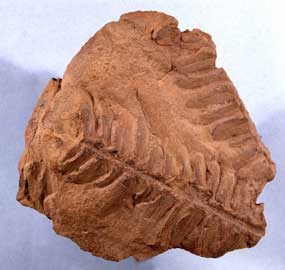
Leaves
In the red layers of the Hermit Shale, plant fossils tin be found in the mudstone and siltstone left behind by an aboriginal river organisation. Indicated by these fossils is a semi-barren climate, with drought-adapted seed ferns, horsetails, modest pines, ginkgos, and a noticeable absence of true ferns. Almost of the plant fossils are impressions, or trace fossils, with little of the plant cloth remaining.
Dragonflies
Oxygen in the atmosphere during the time of the Hermit Shale deposition was in greater affluence than today, probably 35% compared to the present day 21%. Increased oxygen meant larger insects, explaining the eight-inch wingspan of a dragonfly wing impression fossil found in the Hermit Shale.
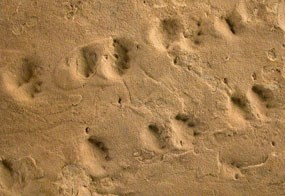
Tracks
Inside the dunes of wind-diddled quartz sand of the Coconino Sandstone, tracks of aboriginal animals are the well-nigh common fossils. Even though no bones have been found, these tracks contain an affluence of information virtually the animals that fabricated them. Scorpions, millipedes, isopods, spiders, and mammal-like reptiles once scurried over these dunes. Their footprints tell the stories of running or walking across the sand, traveling up or down the dunes, whether the animal dragged its tail, how big the animal may have been based on its step length, whether it had an upright or sprawling posture, and what kind of animals shared these dunes.
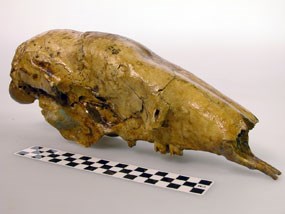
Recent Fossils
The semi-arid climate and cool temperatures deep within coulee caves have combined to create a perfect environment for preservation of more than recent fossils. Pleistocene and Holocene remains take been unearthed within many of these caves, including xi,000 year one-time sloth bones, dung and hair, California condor basic and egg shell fragments, and pack rat middens. These recent remains assistance scientists sympathise more modernistic environmental weather condition and climate change that affected the institute and brute communities within Thou Canyon.
All caves (and mine shafts), with the exception of the Cavern of the Domes on Horseshoe Mesa, are currently closed to visitation. This is for the safety of visitors, the protection of fragile resources such as fossils and unique cave formations, and the preservation of bat habitat. In the 1970s many fossils were lost due to careless visitors leaving a burn down burning in Rampart Cave. These resources are irreplaceable and demand all of us to help protect them.
Interactive 3D Models of Grand Coulee Fossils
Source: https://www.nps.gov/grca/learn/nature/fossils.htm
Posted by: andersonperiond.blogspot.com

0 Response to "On Which Continents Have Similar Animal And Plant Fossils And Similar Rock Layers Been Found?"
Post a Comment